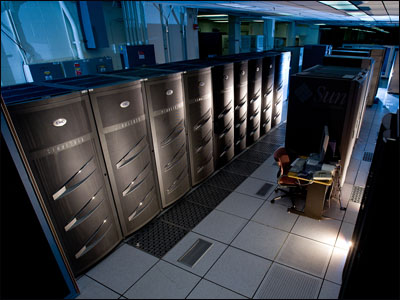Server boxes are now really big, and take up acres of space

The on-premises datacenter is an anachronism. The cloud and software as a service (SaaS) are the enterprise compute resources of the future.

That's the opinion of Scott Weiss, partner with Andreessen Horowitz, recently published in All Things D. Weiss observed that "modern web services, such as Google, Apple, and Facebook, are playing a massive game of Tetris as they grapple with deploying and operating datacenters with tens of thousands of servers versus hundreds. They are all on the bleeding edge of trying to contain costs while cramming as much capacity into a physical building as possible. The result is a complete architectural rethink of datacenter designs, and the incumbent server vendors are struggling to stay relevant in this new reality."
What is happening, Weiss said, is that these giant datacenters are, in effect, becoming the new "servers" — replacing the much, much smaller Dell or HP or IBM System i boxes sitting in the corner of the enterprise. Such a giant supercomputer — "cobbled together from commodity server components and interconnect fabrics" — represents a "profound software and hardware architectural shift that is taking us from a world where datacenters consisted of a small number of independent high-performance branded servers to a brave new world where the giant datacenter building is the server".
Weiss went on to predict that "SaaS will win the enterprise market", predicting that the corporate datacenter will wither away "as on-prem applications give way to their SaaS counterparts".
Weiss makes some forceful points, but it may be a while before the on-premises corporate datacenter slips into extinction. Why? Because right now, there are more private clouds being hosted within organizations than there is public cloud adoption. A new survey I published as part of my work with Unisphere Research among 262 IT and data managers found that 37 percent of enterprises are running or piloting private clouds, and 26 percent are using public cloud services. At least half of the private cloud sites are platform-as-a-service-type implementations, involving application or database servers.
Many non-IT companies are becoming technologically savvy in their own right, and are leveraging both their own IT assets as well as third-party cloud services to build and deliver new capabilities to better understand their customers as well as enhance innovation. We're seeing non-IT companies become cloud service providers themselves, extending private clouds to partners and customers.
What this means for IT managers and professionals is they are increasingly evolving into roles as technology brokers versus implementers, charged with making choices between the best available resources — cloud, SaaS, on-prem, wherever — to deliver power and intelligence to the business. Choice is always a good thing, and let's hope it doesn't get too concentrated into the hands of a few big web services companies, as Weiss suggested. Perhaps a "balance of power" between on-prem and competing outside cloud providers will help ensure that back-end computing doesn't fall into the hands of a few.
(Disclosure: The IOUG survey referenced in this article was sponsored by Oracle, and I was compensated for my work on this project.)